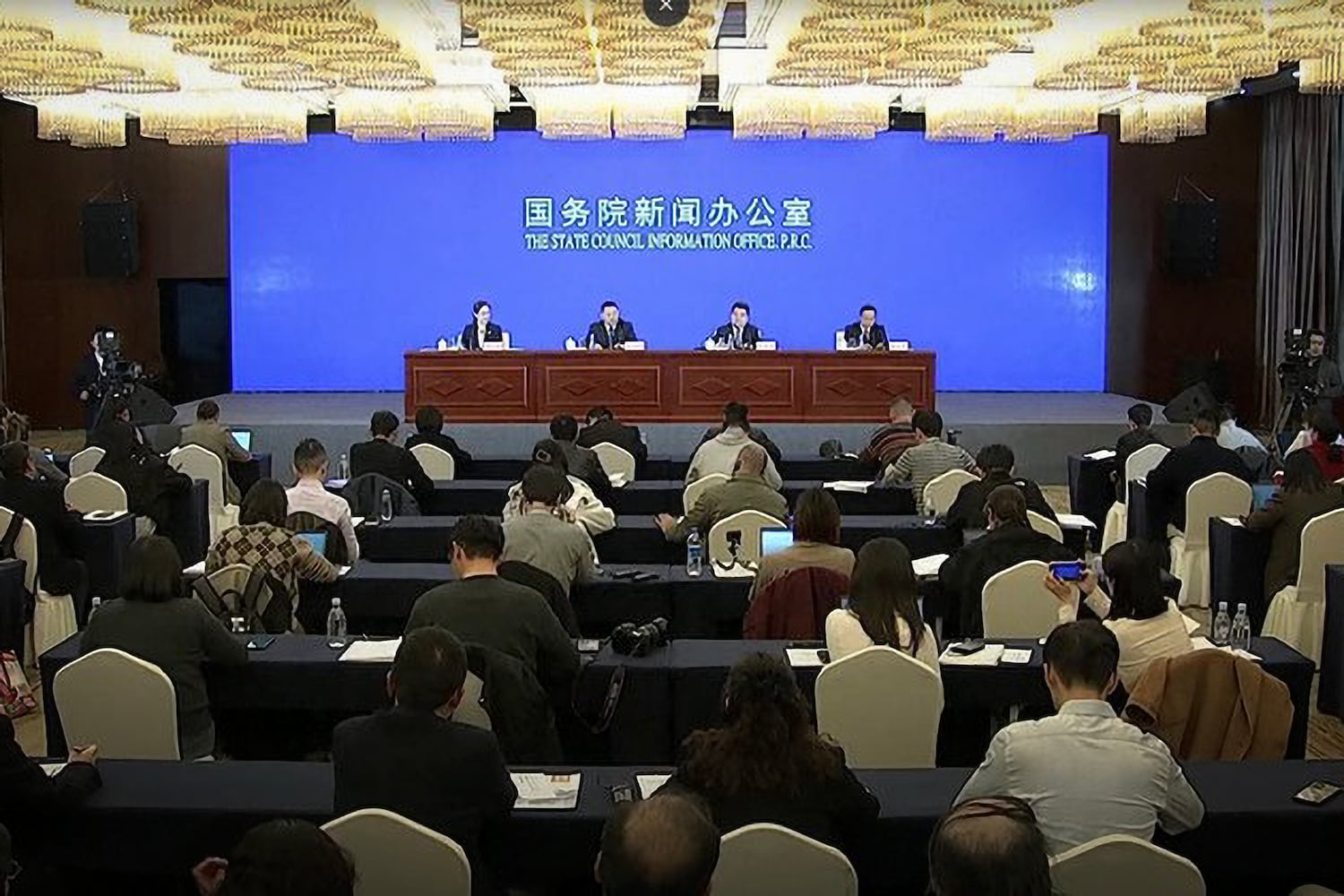“Hindu bachhe kabhi Santa nahi banenge. Hindu sanskriti ka apmaan hum nahi sahenge. Jai Sri Ram!” (Hindu children will never be dressed as Santas. We will not tolerate any insult to the Hindu culture.)
On December 22, 2024, Sudarshan News Jodhpur posted videos on its Facebook channel in which a man can be heard telling reporters this outside Jodhpur’s Shree Mahesh Shikshan Sansthan, also known as the MSS World School.
He proudly proclaims that once Bajrang Dal learned about Christmas celebrations in the school, they made it stop and had the adornments removed. Bajrang Dal is the youth wing of the Vishva Hindu Parishad (VHP), a far-Right Hindu organisation that also has associations with the ruling Bharatiya Janata Party (BJP).
Another video by the propaganda outlet shows this man inside the school. Addressing the camera, he says, “We will not accept this kind of an event (Christmas),” as other men take down the tinsel and decor. The song “Bharat Ka Baccha Baccha Jai Sri Ram Bolega” plays in the background.
The accompanying caption by Sudarshan News Jodhpur said that “conversion had spread like Cancer” under the previous government and, now, under chief minister Bhajanlal Sharma’s regime, Right-wing organisations will “expose anti-national elements one by one.”

What happened in this school, however, was not an isolated instance. In the days leading up to December 25, 2024, numerous social media accounts that identify as pro-Hindu or associate themselves with the Bajrang Dal took to social media, urging parents across the country to refrain from dressing their children as “jokers” — a crude reference to Santa Claus costumes. Below are some examples:
Click to view slideshow.
But it didn’t stop at that. While investigating incidents of targeted hate towards Christians, especially during Christmas, Alt News identified a troubling trend. Many affiliated with or claiming to be affiliated with pro-Hindu organisation Bajrang Dal were targeting schools celebrating Christmas.
District-level social media accounts that identified with Bajrang Dal or the VHP brazenly flexed this intervention by uploading videos showing Christmas decor being stripped off, celebrations being halted and “lessons” being taught to school authorities on what should and should not be celebrated.
Surprisingly, much of the footage that came to our attention was of vigilantes disrupting these celebrations in Prime Minister Narendra Modi’s home state Gujarat.
‘Why Should We Celebrate Their Festival?’
On December 25, the Instagram handle of Vishva Hindu Parishad Gandhidham (@vhp_gandhidham) posted a video showing men wearing saffron stoles with the Bajrang Dal signage claiming that these workers from the Bapunagar district in Gujarat stopped a Christmas program in a school and informed everyone that children are the form of God, not ‘jokers’.
Alt News was able to identify two schools from Ahmedabad in this edited montage — South International School and Rising Kids Preschool in the Naroda and Bapunagar districts, respectively. A ‘Before and After’ comparison in the video by the VHP-associated account showed the schools done up for Christmas taking down all decorations after a conversation between these saffron-clad individuals and school authorities.
An Instagram account going by the name Bajrang Dal Naroda Jila (@bajrang_dal_narodajilla) uploaded multiple videos documenting similar actions by them across various schools in the Naroda district. These videos were deleted after Alt News began reaching out to official members of the Bajrang Dal and VHP for comment.
In one such video posted on December 24, a group of people wearing saffron scarfs with “Jai Sri Ram” written on them in Gujarati are seen speaking to authorities at the Ankur International School. A similar ‘Before-After’ comparison showed decorations previously adorning the primary school being removed. The accompanying caption said that ‘Bajrangi brothers’ went to the school and taught a lesson on Sanatan Dharma in “their own way”.
In another video uploaded by the same Instagram account on December 24, a similar chain of events unfolds at Little Angels’ School. In the video, a saffron-clad man is also seen tearing a hand-painted cutout of Santa Claus to pieces. The caption accompanying the video says that the group protested against celebrations happening on Christmas Eve at the playschool. On the same day, a similar group entered the premises of the district’s Excellent School. A video shows students removing Christmas decorations from the bedecked campus.
Ankur English School in the same area also faced a similar ordeal. In a video shared by the account, a group of people can be seen having an animated discussion with authorities at the academy. One of them says in Gujarati, “They (Christians) comprise only 2% of the population; they don’t celebrate Ram Navami, so why should we celebrate their festival?” He adds that the holiday should not be on account of Christmas but Tulsi Puja Diwas. The caption accompanying this video said that teachers at this school were instructed to teach their students about the values of “Sanatan Dharma” instead of Santa and Christmas.
Meanwhile, another video showed children at Saijpur Sarkari Hindi Medium School being made to chant “Jay Shree Ram” and recite Hanuman Chalisa, a devotional hymn dedicated to the Hindu god Hanuman.
Alt News analysed each of these videos several times to ascertain the schools involved and identify the people in them. We were able to ascertain that while these groups might have been disparate, at least a few faces were common in most of them. All the individuals we tracked from these videos identify as pro-Right on their social media accounts and regularly amplify content linked to the VHP or Bajrang Dal.
Other district-level Instagram accounts associated with the Bajrang Dal or VHP also uploaded similar videos. For instance, on December 25, the accounts of Bajrang Dal Kalol (@bajrangdal.kalol), Bajrang Dal Mehsana (@bajrangdal_mehsana) and Bajrang Dal Nandasan Prakhand (@bajrangdal_nandasan_prakhand) collaboratively uploaded footage of workers directing authorities at Shree Narayana Higher Secondary School in Kathwada to remove decorations. The video clearly shows painted cutouts of Santa Claus with a reindeer and a Christmas tree, likely made by the children there being taken down.
Likewise, on December 24, Bajrang Dal Amaraiwadi (@bajrangdal_amraiwadi) posted footage of a group of saffron-clad men visiting different schools in Ahmedabad’s Hatkeswar locality. The video, which opens with men riding motorcycles and screaming “Jay Shree Ram” on the streets, shows them entering The Mother English School in the area. Here, they have a heated discussion with school authorities and soon after, one of those visibly identifying with the pro-Hindu group can be seen tearing down Christmas and Santa drawings, which looked like they were made by children. In the next shot, another man tears down streamers while a student is seen taking off his Santa Claus costume. The group then goes on to disrupt Christmas celebrations at St. Lawrence Public School.
A deep dive into these videos also led us to the Instagram account of a Pankaj B Nai (@pankajbnai_3636), who identifies as a Bajrang Dal worker. He uploaded the same video claiming, in the caption, that Bajrang Dal workers went to 15 schools in the Hatkeshwar area and put an end to programs deemed contrary to Hindu culture.
Alt News reached out to all of these schools for comment. Four of them anonymously confirmed that these events did happen; people claiming they were from the VHP or Bajrang Dal visited the schools and tried halting celebrations.
“They are little (kids) and we have Christian children studying here as well. We celebrate all festivals. But Bajrang Dal members coerced us into halting the program and sending students home,” a spokesperson from one of the schools said on condition of anonymity. “Humne poocha toh unhone kaha ki upar se order hai.” (When we asked they told us the orders were from higher up.) “We have to live and work here and we have to prioritise the safety of the students and faculty,” this person added when we asked whether they reached out to the police.
Other schools did not comment or elaborate but did not outright deny that it happened.
Alt News also reached out to Vishva Hindu Parishad Gujarat’s spokesperson, Hitendra Rajput, who looked into some of the videos and said that none of the Instagram accounts uploading these videos actually belonged to the VHP or Bajrang Dal. “These are not our workers. These are not verified accounts and we don’t know who these people are, we only have one primary social media account which is for all of Gujarat,” Rajput told Alt News. When asked if the VHP would take any action against these people, Rajput said they would look into it now that it’s come to his attention. He clearly said that the VHP or Bajrang Dal has no official district-level social media accounts.
However, a day after we reached out to Rajput, many of the videos from VHP Naroda’s Instagram account and a few from other VHP and Bajrang Dal-associated accounts were deleted. Alt News had archived them when they were live. Additionally, these accounts that Rajput said were not officially affiliated to VHP or Bajrang Dal regularly share images and videos of VHP-led events and programs.
Gujarat Leads the Charge, Other States Follow
While our investigation primarily focused on Gujarat, we found more such incidents of Right-wing vigilantes teaching schools “a lesson” in other states as well.
One video from Nakur in Uttar Pradesh’s Saharanpur district shows a group of men entering a school named Our Heaven Academy, where a program is going on and some can be seen wearing Santa Claus hats. When we reached out to the school, they said that Bajrang Dal workers tried to stop a “farewell program” that coincidentally happened to take place on December 25 and asked why students were in school on a holiday.
On December 20, in Kerala’s Palakkad district, three VHP members entered the premises of Nallepilly Government Upper Primary School, which was decked up for Christmas and proceeded to vandalize the decorations. The school authorities filed a complaint in which they said that VHP members questioned and verbally abused them. Workers of the Right-wing body reportedly asked whether the school observed Krishna Jayanti before calling them out for celebrating Christmas.
The three members, identified as K Anilkumar, V Susasanan, and K Velayudhan, were arrested by the police for harassing the school faculty. Three days after this, a Christmas crib arranged for celebrations at the Government Boys School at Thathamangalam, in Palakkad, was destroyed.

Many of the incidents that Alt News documented were available on social media and in the public domain, easily accessible for all to see. But this also means that there could be more such cases that may never come to light because there is no record of them online or, like in the case of the videos by VHP Naroda Jila, have now been wiped away from the digital space.
The post ‘Why should Indian schools celebrate Christmas?’ Saffron sees red, strikes appeared first on Alt News.
This content originally appeared on Alt News and was authored by Shinjinee Majumder.
This post was originally published on Radio Free.





